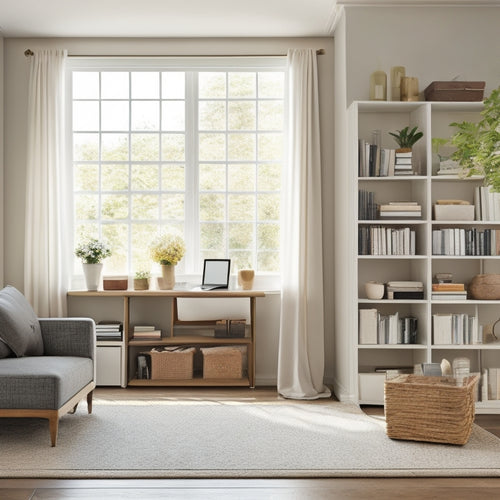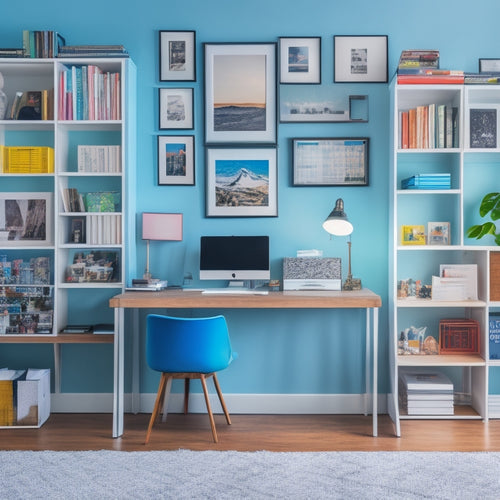
Maximizing Space in Small Closets: Pro Tips
Share
You're likely among the 60% of Americans who feel their closet is too small, but with the right strategies, you can double or even triple your storage capacity. Start by appraising your closet's potential, taking note of its dimensions, obstructions, and current storage solutions. Then, purge and categorize your essentials, assigning a home for each group. Optimize your shelf and rod space with dividers and hanging organizers, and utilize hidden storage areas like top shelves and behind-the-door organizers. By implementing multifunctional solutions, you'll be on your way to a more efficient closet – and it's just the beginning of uncovering your closet's hidden potential.
Key Takeaways
• Assess your closet's dimensions, location, and obstacles to optimize storage and functionality.
• Purge and categorize essentials, assigning a home for each category to prevent clutter buildup.
• Utilize shelf dividers, hanging organizers, and double rod closet organizers to maximize vertical storage.
• Leverage hidden areas like top shelves, behind-the-door storage, and under-shelf compartments for additional storage.
• Incorporate multifunctional solutions like ottoman storage benches and hanging organizers with pockets for efficient use of space.
Assessing Your Closet's Potential
You regularly open your closet door, only to be greeted by a cluttered mess, but before you can maximize the space, you must evaluate your closet's layout and identify areas that can be optimized.
Take note of the dimensions, including the width, depth, and height of the space. Consider the location of any windows, doors, or obstructions that may impact your storage solutions.
Next, examine your current storage solutions, such as shelves, rods, and drawers. Are they functional and efficient, or are they contributing to the clutter?
Think about what you need to store, from clothing and accessories to shoes and bags. Consider the frequency of use and the type of items you need to access regularly.
Purging and Categorizing Essentials
Now that you've assessed your closet's layout and storage needs, it's time to tackle the clutter by purging items that no longer serve a purpose and categorizing the essentials that make the cut. This pivotal step in the decluttering process will help you identify what you truly need and what can be donated, sold, or discarded.
Start by sorting items into three piles: keep, donate/sell, and discard. Be honest with yourself – if you haven't worn or used something in a year, it's likely safe to let it go.
Next, use organizing techniques like categorizing similar items together and assigning a home for each category. For example, group all your tops together, then sort them by type, such as t-shirts, blouses, and sweaters. This will make it easier to find what you need and prevent clutter from building up again in the future.
Optimizing Shelf and Rod Space
With a curated collection of essentials in hand, it's time to focus on maximizing the shelf and rod space in your closet, where strategic placement and clever storage solutions can make all the difference. To optimize your shelf space, consider using shelf dividers to separate items and keep them organized. This will help prevent clutter from building up and make it easier to find what you need.
For your rod space, utilize hanging organizers to double your storage capacity. This is especially useful for items like dresses, coats, and jackets that take up a lot of space. By implementing these solutions, you'll be able to fit more items in your closet without it feeling cramped.
Here are some key strategies to keep in mind:
| Storage Solution | Benefits | Tips |
|---|---|---|
| Shelf Dividers | Keep items organized, prevent clutter | Use dividers to separate items by type or category |
| Hanging Organizers | Double storage capacity, maximize vertical space | Hang items by type, like dresses or tops |
| Vertical Storage | Make the most of your closet's vertical space | Use stackable shelves or hanging organizers to maximize space |
Utilizing Hidden Storage Areas
Frequently overlooked, hidden storage areas in your closet can be leveraged to stash items that are infrequently used or require special care. By utilizing vertical space and incorporating underutilized areas, you can create additional storage without sacrificing floor space.
Here are four hidden storage areas to bear in mind:
-
Top shelf storage: Install a shelf or basket above your closet rod to store out-of-season clothing or luggage.
-
Behind-the-door organizers: Use over-the-door storage racks, hooks, or baskets to hang belts, scarves, or bags, keeping them organized and out of the way.
-
Under-shelf storage: Add a slide-out drawer or basket under a shelf to store items like socks, underwear, or accessories.
- Inside-the-closet cubbies: Create a hidden compartment by adding a cubby or shelf inside the closet wall, perfect for storing valuable or sensitive items.
Implementing Multifunctional Solutions
You can further optimize your closet's functionality by incorporating multifunctional solutions that serve more than one purpose, allowing you to make the most of the available space. This approach enables you to create a more efficient and organized closet, perfect for small spaces.
Here are some examples of multifunctional solutions you can implement:
| Space Saving Furniture | Creative Storage | Compact Solutions |
|---|---|---|
| Ottoman storage bench | Hanging organizers with pockets | Double rod closet organizers |
| Shelf dividers with bins | Stackable shoe racks | Foldable storage cubes |
| Closet organizers with drawers | Under-shelf baskets | Adjustable shelving units |
Frequently Asked Questions
Can I Use a Small Closet for Multiple Family Members' Storage?
You can definitely use a small closet for multiple family members' storage by implementing shared closet organization strategies and utilizing vertical space with stackable shelves or hanging rods to maximize capacity.
How Do I Organize Seasonal or Out-Of-Season Clothing Efficiently?
As you dance around the dilemma of storing seasonal clothes, think outside the box - or closet. You'll find solace in vacuum storage and garment bags, or under bed storage and rotating racks that keep items accessible yet out of sight.
What Are Some DIY Storage Solutions for Small Closets on a Budget?
You can create DIY storage solutions on a budget by repurposing items like shoe racks and basket systems, or utilizing hanging organizers and drawer dividers to maximize your small closet's space.
Can I Install Shelves and Rods Myself, or Do I Need a Professional?
"You're a DIY dynamo, ready to tackle closet space optimization! With some patience and planning, you can install shelves and rods yourself, no pro needed. Just measure, mark, and mount for a perfectly organized closet."
How Do I Prevent Clutter From Building up Again After Organizing?
To prevent clutter from building up again, you'll need to establish maintenance habits, like regularly purging items, using storage bins, and implementing a 'one in, one out' policy to guarantee your newly organized closet stays that way long-term.
Related Posts
-

10 Essential Skills for Mastering Home Organization
You're ready to take control of your space and transform it into a haven of calm and productivity. Mastering home org...
-

10 Essential Digital Tools for Small Space Living
You're looking to maximize your digital tools to minimize clutter and streamline your small space living. Start by ut...
-

Top Digital Tools for Home Organization Success
To achieve home organization success, you'll want to tap into the power of digital tools. Start with decluttering and...


